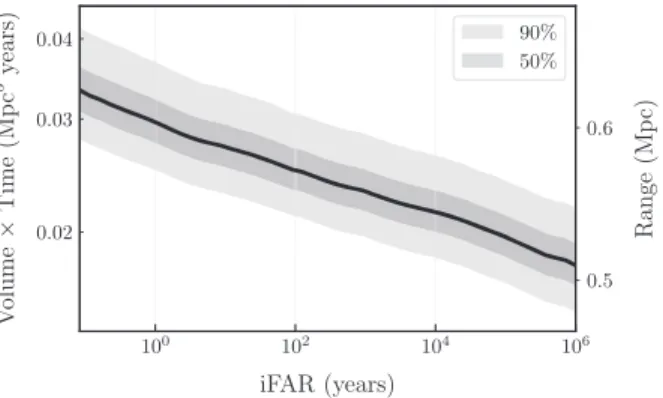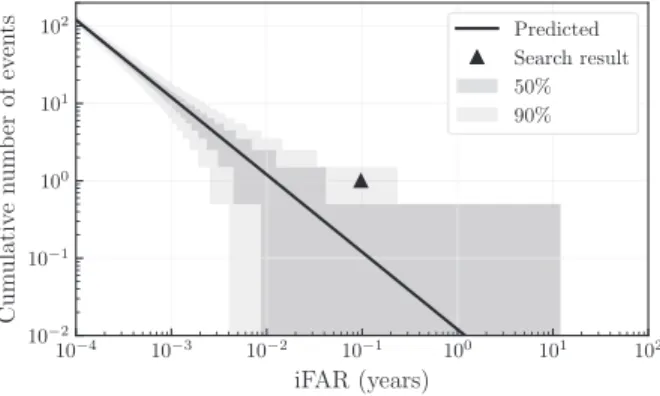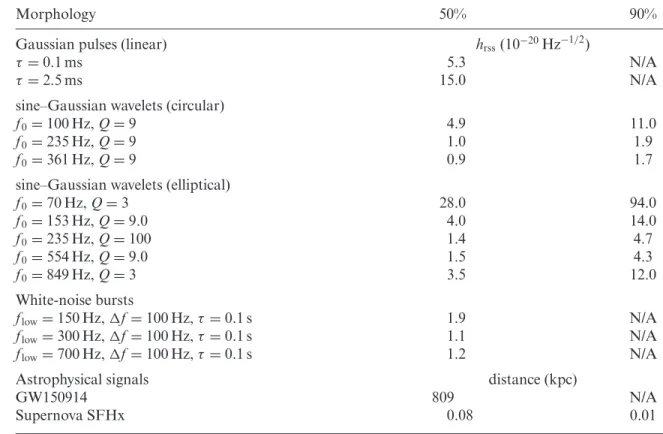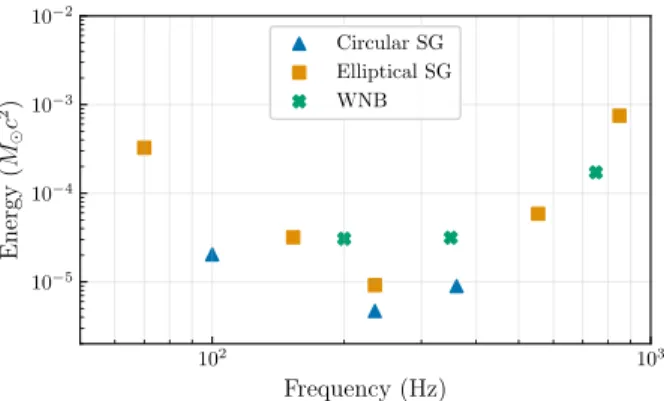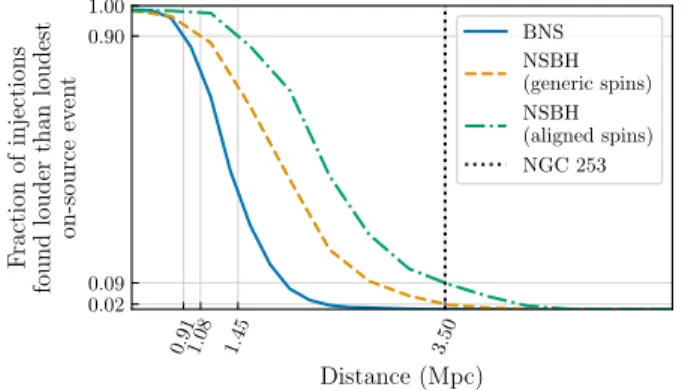28Research Center for the Early Universe (RESCEU), University of Tokyo, Bunkyo-ku, Tokyo 113-0033, Japan. 187Institut for Cosmic Ray Research (ICRR), KAGRA Observatory, University of Tokyo, Kashiwa City, Chiba 277-8582, Japan. 189 Institute for Cosmic Ray Research (ICRR), KAGRA Observatory, Tokyo University, Kamioka-cho, Hida City, Gifu 506-1205, Japan.
273Institute for Cosmic Ray Research (ICRR), Research Center for Cosmic Neutrinos (RCCN), University of Tokyo, Kashiwa City, Chiba 277-8582, Japan.
Introduction
We estimate the minimum detectable amplitude for different types of transient signals and the spatiotemporal volume for which the network is sensitive to neutron star binary coalescences. We also place lower limits on the distances to gamma-ray bursts analyzed from the non-detection of a coupled gravitational wave signal for several signal models, including binary coalescences. These analyzes demonstrate the feasibility and utility of KAGRA as a member of a global network of gravitational wave detectors.
5 we present the compact binary coalescence (CBC) and burst searches following GRBs observed during the joint run.
GEO–KAGRA observing run 1 KAGRA
GEO 600
The GW signal is read by adjusting the length of the differential arm slightly outside the dark edge, to couple the movement of the differential arm to the DC power at the output. Figure 1 shows representative sensitivities of the detectors during the run, as measured by the spectral amplitude density of the calibrated strain output, and the evolution of the detectors' sensitivity over time, as measured by the BNS inspiratory range. Table 1 shows the observation times and duty cycles for two interferometers, the latter defined as the percentage of the total runtime during which the instruments observed.
One was that alignment sensing and control using wavefront sensors had not been implemented by the time of the run, so the interferometer could not be used for long periods of time. Furthermore, after losing lock of the interferometer, it often took a long time to adjust the alignment to recover the lock. The narrow peaks in the spectra are due to sources such as resonances of the suspension system (violin modes) and harmonics of the electrical grid frequency (50 Hz for GEO and 60 Hz for KAGRA) [52,53].
While KAGRA's quiet underground environment provides advantages to the instrument's performance, KAGRA is not completely unaffected by bad weather. The voltage data from each interferometer is generated by processing and combining the raw electronic signals coming from the differential arm length control using a detailed model of the control system, including the optical response of the interferometer. KAGRA did not implement data quality flags until joint implementation; it is planned to be introduced before the next observation.

All-sky binary search
This subset of the O1 template bank was tested against a set of BNS signals with masses uniformly distributed over the search mass range and using noise power spectral densities typical of GEO and KAGRA during their joint run. We define the network SNR as the root-sum-square of the SNRs for coincident triggers, and simply the SNR for non-coincident triggers. GstLAL ranks candidate events based on the logarithm of the likelihood ratio L, which is a measure of how signal-like a given event is.
The likelihoods used in this analysis are constructed using SNR, a test of signal consistency, the differences in time and phase between triggers from different detectors when the candidate event consists of random triggers whose detector set information ({GEO}, {KAGRA} or {GEO, KAGRA}) from the event, the sensitivity of the detectors to the exact mass of the template at the time of the event, the rate of excitation in each of the detectors at the time of the event, and the relative frequency with which signals are expected to be recovered from each template given the assumption that the astrophysical sources are uniformly distributed in the logarithm of the masses. Figure 2 shows the number of events as a function of the threshold in the inverse false alarm rate (iFAR). We see no significant deviation of the observed distribution from our noise model and conclude that no signal of interest has been detected.
Sensitive space-time volume for BNS merges with component masses drawn from N(1.4M,[0.01M]2) as a function of the threshold on iFAR for theGstLALbinary search. Figure 3 also shows the equivalent sensitive range, defined as the radius of a sphere of the same average spatial volume, which can be compared with Fig. The iFAR of the most significant candidate corresponds to a range of ∼0.6 Mpc, which can be taken as the approximate sensitive range of this analysis.
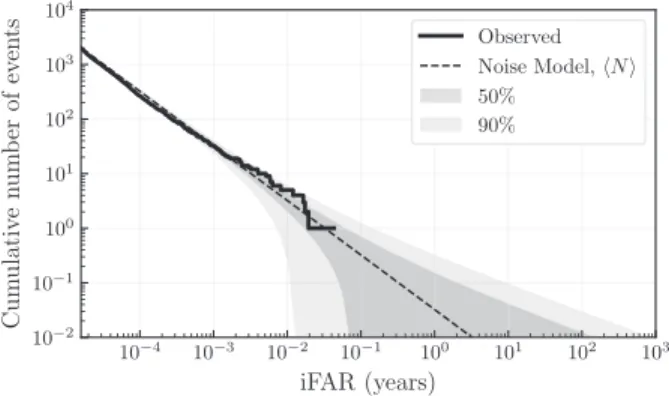
All-sky burst search
Given that the sensitivity of the GEO–KAGRA network is limited to frequencies ࣠100 Hz and 1 kHz (see Figure 1), our analysis covers the frequency range 64–1024 Hz. Similar to other observations, we use a variety of ad hoc waveforms, including sine-Gaussian (SG), Gaussian pulses (GA), and band-limited white noise bursts (WNB), with frequencies and durations spanning a range of possible values. The SG signals are defined by their central frequencyf0 and the quality factor Q, which determines the duration of the signals.
In addition to these ad hoc signals, two astrophysically motivated signals are used: the reconstructed signal of GW150914 [1] and a simulated core-collapse supernova waveform referred to as SFHx [87]. The GW released energy in units of solar masses (Mc2) corresponding to a 50% detection efficiency with cWBat an iFAR of ≥1 year, for a source located at 10 kpc. These signals are then retrieved using the search method described above and the detection efficiency is defined as the fraction of signals that produce an event that passes the selection cuts and has an iFAR≥1 year.
Table 2 shows for each waveform type the hourly amplitude at which the detection efficiency reaches 50% and 90%. This equation applies to unpolarized signals such as WNBs, while for SG signals the emission from the rotating system must be taken into account by the right-hand side of Eq. 2) and the hourly limits from Table 2 we can estimate the minimum energy required to be radiated by a population of standard candle sources at a distance of r=10 kpc to obtain a detection efficiency of 50%. Again, the overall behavior is determined by the power spectral density of the network (Figure 1).
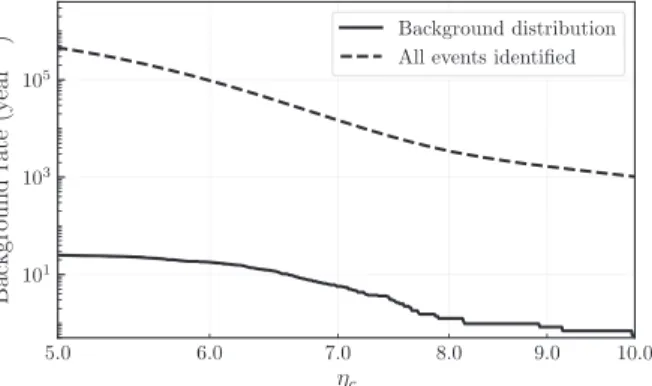
Gamma-ray burst analyses
The loudest (most significant) candidate event in the on-source window, as defined by the detection metric, is compared to a list of the top background events from each of the six-second background trials within the off-source window. The sensitivity of the search is evaluated using simulated GW signals inserted into all external data and distributed over the region(s) of sky corresponding to the positional uncertainty of the GRB trigger. The injection recovery in this case was limited by the large sky error of the GRB.
The frequency range of the search is increased from the default values of [20, 500] Hz to Hz to account for GEO's better sensitivity at higher frequencies. The outer source window consists of all data within ±90 min of the GRB, including time offsets similar to those used by cWB. Finally, simulated signals are added to the source window; it is used both to estimate the sensitivity of the search and for automatic tuning of X-Pipeline's background rejection tests.
Thresholds for these background rejection tests are chosen to maximize detection efficiency with a user-specified false alarm probability (10−4 for this analysis), using a subset of the out-of-source and simulation sets. Sensitivity as a function of signal amplitude or source distance is estimated as the fraction of simulated signals that yield surviving events with p-values lower than the lowest p-value of source events. Figure 8 shows the lower 90% confidence level limit on the distance for each of the GRBs for several emission models: accretion disk instability model A of Refs.

Summary and discussion
90% confidence level exclusion distances for each of the GRBs analyzed by the Generic X-pipeline burst search, for model A of the accretion disk instability (ADI) signal, and for circular sine-Gaussian (CSG) signals at 150 Hz, 500 Hz, and 1000 Hz. The lack of detected GWs in this direction is expected given the sensitivity of the GEO–KAGRA network at that time. However, KAGRA's sensitivity is expected to improve by more than two orders of magnitude later this decade [6], becoming comparable to that of the LIGO and Virgo detectors.
We look forward to the scientific contributions of KAGRA in the coming years as a member of the global network of GW detectors. The authors also acknowledge the support of the UK Science and Technology Facilities Council (STFC), the Max Planck Society (MPS) and the Land of Niedersachsen/Germany for supporting the construction of Advanced LIGO and the construction and operation of the GEO 600 detector. The authors thank the Italian Istituto Nazionale di Fisica Nucleare (INFN), the French Center National de la Recherche Scientifique (CNRS) and the Dutch Organization for Scientific Research (NWO) for the construction and operation of the Virgo detector and the establishment and support of the EGO consortium.
Los autores también agradecen el apoyo de estas agencias, así como del Consejo de Investigación Científica e Industrial de la India, Departamento de Ciencia y Tecnología, Junta de Investigación en Ciencia e Ingeniería (SERB) de la India, Ministerio de Recursos Humanos. Desarrollo de Recursos Naturales, India, la Agencia Estatal de Investigación (AEI), el Ministerio de Ciencia e Innovación y el Ministerio de Universidades de España, la Conselleria de Fons Europeus, la Universitat i Cultura y la Dirección General de Política Universitaria del Gobierno de Baleares Islas, la Conselleria d'Innovación, Universitats, Ciència i Societat Digital de la Generalitat Valenciana, y el programa CERCA Generalitat de Catalunya, España, el Centro Nacional de Ciencias de Polonia, y la Unión Europea – Fondo Europeo de Desarrollo Regional; Fundación para la Ciencia Polaca (FNP), la Fundación Nacional Suiza para la Ciencia (SNSF), la Fundación Rusa para la Investigación Básica, la Fundación Rusa para la Ciencia, la Comisión Europea, los Fondos Sociales Europeos (FSE), los Fondos Europeos de Desarrollo Regional (FEDER), la Royal Society, el Scottish Funding Council, la Scottish Universities Physics Alliance, el Fondo Húngaro para la Investigación Científica (OTKA), el Instituto Francés de los Orígenes de Lyon (LIO), el Fonds de la Recherche Scientifique belga (FRS-FNRS), Actions de Recherche Concertées (ARC) y Fonds Wetenschappelijk Onderzoek – Vlaanderen (FWO), Bélgica, la región de París Île-de-France, la Oficina Nacional de Investigación, Desarrollo e Innovación de Hungría (NK-). Los autores agradecen el apoyo de NSF, STFC, INFN y CNRS por proporcionar recursos informáticos Advanced Research Networks, JSPS Grant-in-Aid for Scientific Research (S) 17H06133 y 20H05639, JSPS Grant-in-Aid for Transformative Research Areas (A) 20A203: programa JP20H0585 del Institute for Cosmic Investigación sobre Radiación, Universidad de Tokio, Fundación Nacional de Investigación (NRF), Proyecto de Infraestructura de Computación de KISTI-GSDC, Instituto de Astronomía y Ciencias Espaciales de Corea (KASI) y Ministerio de Ciencia y TIC (MSIT) de Corea, Academia Sínica (AS), AS Grid Center (ASGC) y el Ministerio de Ciencia y Tecnología (MoST) en Taiwán bajo subvenciones que incluyen AS-CDA-105-M06, el Centro de Tecnología Avanzada (ATC) de NAOJ y el Centro de Ingeniería Mecánica de KEK. Nos gustaría agradecer a todos los trabajadores esenciales que pusieron en riesgo su salud durante la pandemia de COVID-19, sin los cuales no podríamos completar este trabajo.

